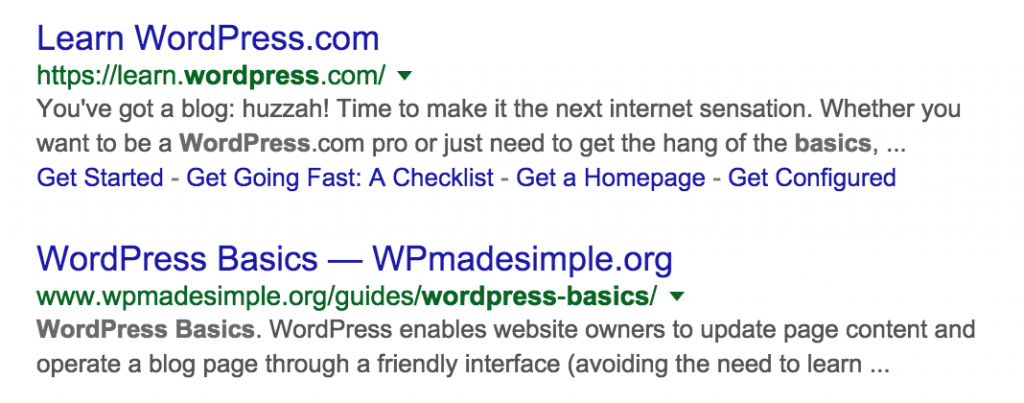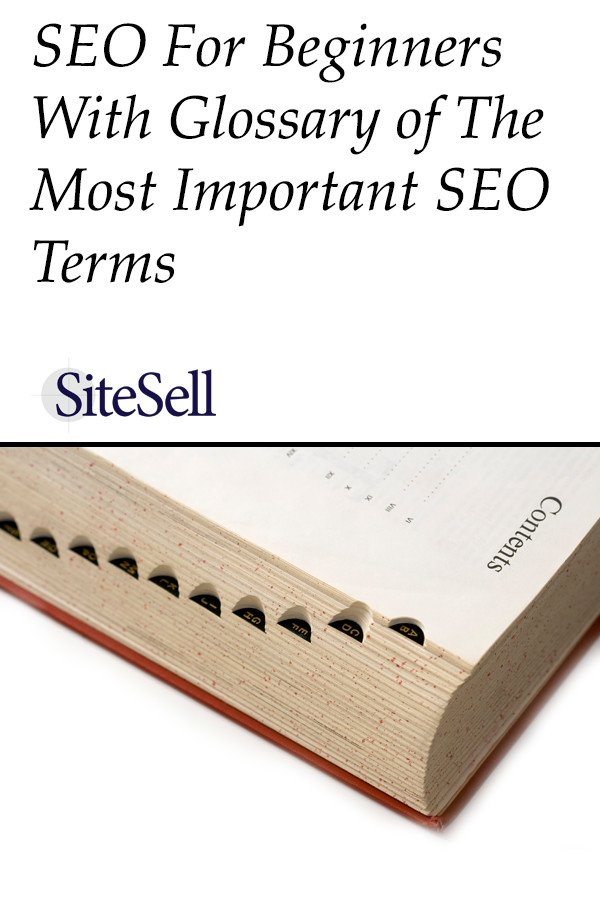SEO (Search Engine Optimization) is a term that’s bandied about frequently. We all know it’s important, but when you’re just starting to build your online business, understanding SEO can seem like scaling Mt. Everest.
Here are the basics you should know to get started with SEO, but before we begin, relax and breathe.
Just as you didn’t need to have a working knowledge of light-spectrum physics before you set your first crayon to paper, you can start working on your SEO by taking baby steps while you learn more.
The primary -- and most important -- ingredient in good SEO is original, quality content.Click To Tweet So focus on creating the best possible content to give your site a good start on SEO.Understand what SEO Is — and Isn’t
SEO is what you do to make it easy for search engines to understand what your site is about, and serve the relevant page to the person who’s searching.
The goal of Google, Bing, and other search engines is to serve the most relevant content to a searcher. Your job is to make it easy for them to determine that your content is relevant, and you do that with SEO.
SEO is not a series of tricks or formulas. There’s no magic number of times a certain word needs to show up on a page (a common misconception, by the way).
How do the Search Engines Decide What is Relevant?
It’s a complicated set of ingredients, baked into a mathematical formula called an algorithm. These algorithms are never made public, but Google lets us know what they’re paying attention to. They look at:
- Content. Is it original? High quality? Content includes more than just the text on the page. It also includes titles and descriptions (more on those shortly).
- Performance. How quickly does the page load? If it takes too long, users will click away before they even discover your great content. This doesn’t make for a good search experience, so the search engines will drop your site in their rankings.
- User experience. This includes elements like site design and layout, and ease of navigation. If you have terrific content but it takes too many clicks to get to, users will click away. Mobility is important, too. With over 30% of internet users now viewing websites on a phone or tablet, Google drops your search ranking in mobile searches if your site doesn’t meet their mobile friendly standard.
- Authority. If other sites in your industry or niche link to your site, that’s a good indication that it’s authoritative. If you don’t have those links yet, don’t worry. If you’re providing great content for your readers, those links will come.
SEO Starts Before You Build your Site
Some of your most important SEO happens before you even begin building your website.
Choosing a speedy web host is important (you get that automatically if you’re using SBI!). And choosing the right domain name can make a big difference. If at all possible, choose a domain name that includes your most relevant keyword.
For example, if your site is about designing beaded handbags, choose a domain name like DesigningBeadedHandbags.com, or BeadedHandbagDesign.com. Don’t call it CraftsByMary.com. Having those three keywords in the domain name lets the search engines know that your site is all about designing beaded handbags. Crafts by Mary doesn’t provide much for a search engine to use.
What’s a Keyword, Anyway?
A keyword (sometimes called a keyphrase) is a word that tells the search engines what your site, or a particular post or page, is all about.
A keyword can be two, three or even four words long, but we still refer to it as a keyword, or, alternatively, a keyphrase.
Other Important Terms
Here’s a list of other important SEO-related terms you should know.
301 Redirect: A way to automatically send a visitor to a different page. Use it if you’ve renamed a page to avoid a broken link.
Backlink: Also called an Inbound Link. It’s a link from one website to another website. If it’s inbound, it’s a link from someone else’s site to yours.
Black Hat SEO: Inappropriate use of SEO tactics and strategies. These tricks may boost rankings in the short term, but are likely to get the site downgraded or non-indexed. Definitely not a good idea.
Canonical URL: The search engines frown on duplicate content — originality is heavily weighted. Sometimes there’s a good reason for you to have the same information in two places. If you do, specify the canonical URL to let the search engines know which address should be considered the original. (If you’re using the Yoast SEO plugin on a WordPress site, you’ll do this in the Advanced tab.)
Directory: Just like we have telephone directories, there are web directories. Directory listing is less important today than it has been in the past, but if you can get your site listed in a prestigious directory for your industry or niche, it’s worth doing. Stay away from low-value directories, however.
Domain: The main address for your website.
Fold: There’s been ongoing debate about whether you get more value from content that’s placed “above the fold” or “below the fold” on your web page. The “fold” refers to a paper newspaper, where content appearing above the physical fold was more widely read than content below the fold. Recent studies indicate that, in today’s internet, there’s not a significant difference.
Google PageRank(™): a numeric value of importance
Headings: To a reader, these show up as bigger, bolder type on the page. To a search engine, they’re text enclosed in “H” tags. (H1 indicates the highest importance.) The tag tells the search engine how important those words are and they do have SEO value. Even if they appear visually the same size, a search engine will give more prominence to an H2 tag than an H3 tag.
Inbound Link: A link from another website to yours.
Internal Link: A link connecting two locations within the same website.
Keyword Density: The number of times a keyword appears on a page, in relation to the total number of words on the page. Some still believe there are advantages in having a high keyword density, but that’s not borne out by facts. SEO expert Heather Lloyd Martin refers to this as “an SEO myth.”
Keyword Research: Systematically reviewing and/or evaluating a keyword’s effectiveness. It refers both to figuring out what keywords to use, and to keeping an eye on them to see how well they’re working for you. This is crucial to your success, because you’ll build your content around the keywords you uncover.
Latent Semantic Indexing: also referred to as LSI, or semantic search, is a sophisticated algorithm that determines a word’s relationship to other words near it. Does “cookie” refer to a piece of code a site puts into your web browser, or is it something you eat? Or something your dog eats? If words like “browse,” “page,” or “website” are nearby, Google can determine it’s a web cookie. If “chocolate chips,” “dessert,” or “snack” show up in close proximity, it’s something Cookie Monster would like. If “beef flavor,” then it’s a snack for Fido.
Link Building: The process of getting more links pointing to your website for the purpose of improving SEO.
Long-Tailed Keyword: A keyword of three, four or more words. When you’re just starting and have a small site, these are the words to focus on. For example, if you’re a real estate agent in a large metro area, chances of ranking well for “real estate” are effectively zero. But if you’re an agent who specializes in waterfront property in Central Florida, you could rank well and quickly for “Central Florida waterfront real estate,” “Orlando, Florida waterfront real estate,” etc. When you’re starting out, focus on the long-tailed keywords where you’ll have the best chance of a high ranking.
Meta Data: The words you use to tell search engines what your site is about.
Meta Description: This is important and specific. It’s a small block of text — 160 characters or fewer — that the search engines show on results pages. It’s one of the areas where you should spend extra time before you publish a new page.
Here are two listings I found when I searched for “WordPress basics.” It’s pretty obvious why one ranks more highly than the other when you look at the description underneath the bold text. The first is interesting and encourages the click. The second… yawn.

Meta Tag: Not used much anymore, but you might run across the term. It was common practice to add a list of keywords to a page header to let the search engines know what the page was about. With the improvement of semantic search, meta tags have fallen into disuse.
Nofollow: A way of telling the search spiders not to follow a particular link.
Organic Search: Just a fancy way of saying “free.” Organic search results are the ones that aren’t paid for.
Paid Search: Not free. You can advertise and pay for placement on search pages.
Page Title: The name of the web page, which should include a keyword. Your page title, for SEO, can be different from the title your visitors see.
SEM: Search Engine Marketing.
Search Engine Optimization (SEO): Steps you take to improve your site’s visibility to the search engines. It can happen on site, or off site. Guest posting is an example of off-site optimization.
SERP: Search Engine Ranking Page. (I always think of it as the search engine results page.)
Sitemap: A list of the pages on your website, presented so the search engines can read it.
Spider: A program that automatically performs tasks on the web. A search engine spider travels the internet indexing web pages. It’s also known as a robot, or bot.
Title Tag: This is meta data that search engines pay attention to. It can be the same as your Page Title, or it can be different. It is the title tag that shows in SERPs, not the page title.
Traffic: Your site visitors.
URL: Uniform Resource Locator, the official designation for a web address.
White Hat SEO: Appropriate use of SEO tactics and strategies.
That’s a Lot of Information. Where do I Start?
Jason Demers of Forbes recommends starting with a minimalist approach to SEO. Focus on these four elements of good SEO:
- Produce terrific, original content
- Build relationships with authorities in your industry or niche
- Share your content through social media and engage socially
- Always look for ways to improve the user experience on your website
If you use SBI! or SBI! for WP, you’ll find more information and help with SEO — in the Action Guide, in the Tips and Techniques articles, and in the forums.
To uncover keywords you can use to write content about, if you’re using WordPress, we recommend subscribing to SBI! for WP.
And to add the information search engines look for on each page or post, install the Yoast SEO plugin, at https://wordpress.org/plugins/wordpress-seo/.

Latest posts by Susanna Perkins (see all)
- How To Review, Reinvent And Revitalize Your Growing Solopreneur Business - September 8, 2016
- 6 Tools to Help You Corner Your Share of a $107 Billion Industry - July 11, 2016
- WordPress – Not Just for Bloggers Any More - July 6, 2016


